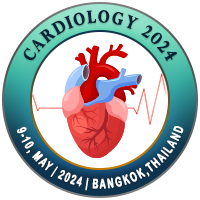
Raja Ramesh Nukavarapu
Aster Ramesh Hospitals, IndiaTitle: Novel commissural alignment technique with newer generation balloon expandable myval octacor valve in TAVR (Transcatheter Aortic Valve Replacement).
Abstract
As the TAVR indications were extending to lower surgical risk and younger patients it is important to achieve commissural alignment (CA) of transcatheter heart valve (THV) with native commissures for lifetime management of aortic stenosis. This CA facilitates future coronary access, redos TAVR, and reduces stress on THV leaflets and thereby degeneration. Different techniques were described for CA with self-expanding supra-annular valves but attempts with balloon-expandable valves were disappointing and these techniques hold good only for tricuspid aortic valves. Here we are describing a novel CA technique called OCTA ALIGN with newer generation balloon expandable THV named Octacor Myval by Meril (India) which suits both tricuspid and bicuspid anatomies. The core concept of the OCTA ALIGN technique is to align any one commissural post of Myval octacor THV with mid of RCC right coronary sinus (in case of tricuspid valve) or with mid of RCA right coronary artery (in case of bicuspid valve) as seen in CT scan derived image. When Octacor is deployed by this method the chance of CA increases. As there will be a 180-degree rotation of the aorta from the femoral site to the aortic root, the commissural post initially crimped in the direction of mid of RCC or RCA exactly falls opposite to them (mostly at NCC-LCC native commissure) during deployment creating CA which will be confirmed on fluoroscopy and post-procedure CT.
Biography
Dr. Raja Ramesh Nukavarapu has completed his MD in internal medicine from Manipal University and DM in cardiology from JIPMER. Working as a senior interventional cardiologist at Aster Ramesh Hospital, Vijayawada India. Has many publications in national and international journals and acting principal investigator for many international clinical trials.

